Key Review Takeaways
- Highly functional design.
- Tough steel that is easy to sharpen.
- Comfortable handle shape..
- A bit too heavy for comfortable work.
- The bottle opener is a nice touch
It’s a shame I tested this knife during the winter, because it’s a purebred summer-grilling fiend. It’s a bone crushing, meat slicing, cap popping thing of beauty that felt frustratingly out of place over the holiday season. But having to use this inside most of the time did force me to find its range.
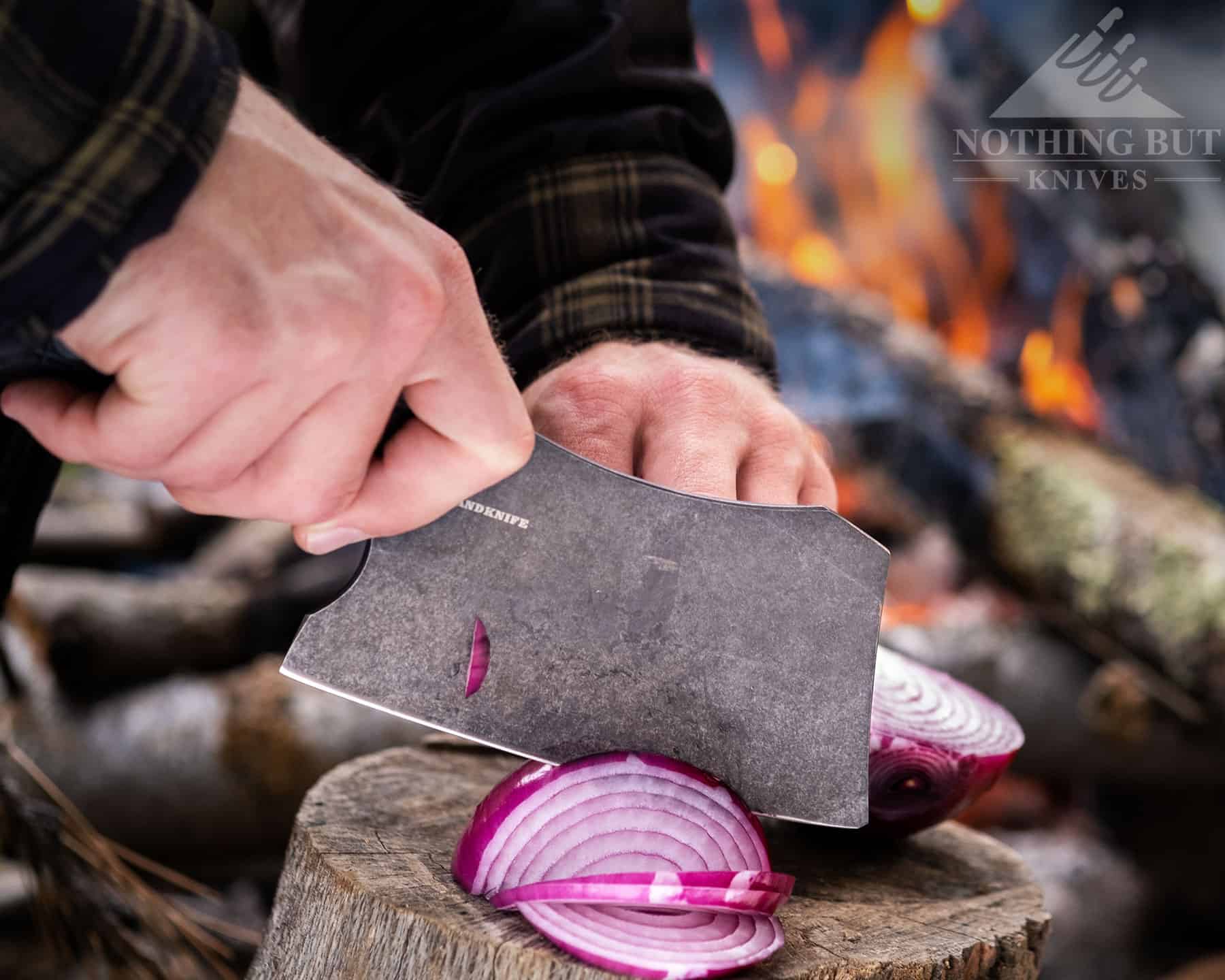
I expected to tell you that Vosteed’s Minibarbar cleaver is great to have by the grill but too clunky to keep in the kitchen. I still hold to that view, but not as strongly as I thought I would. There’s no doubt this thing is heavy, but it’s surprisingly good at certain vegetables and mushrooms. I didn’t like it for most things in the middle of greens and meat, but it does well in the right context.
Specifications
| Overall Length: | 10.5” |
| Blade Length: | 6” |
| Blade Steel: | 7Cr |
| Blade Thickness: | 4 mm |
| Blade Shape: | Cleaver |
| Blade Grind: | Flat |
| Handle Length: | 5” |
| Handle Material: | G10 scales |
| Sheath: | Leather |
| Weight: | 381.3 g (13.45 oz) |
| Designer: | |
| Made in: |
Pros
| Great edge for meat and greens |
| Nice pinch-grip ergos |
| Bottle opener works like a charm |
Cons
| A little heavy |
| Not so great for cutting carrots or dicing onions |
The New Vosteed Grandknife Cleaver is a Barbecue and Camping Beast
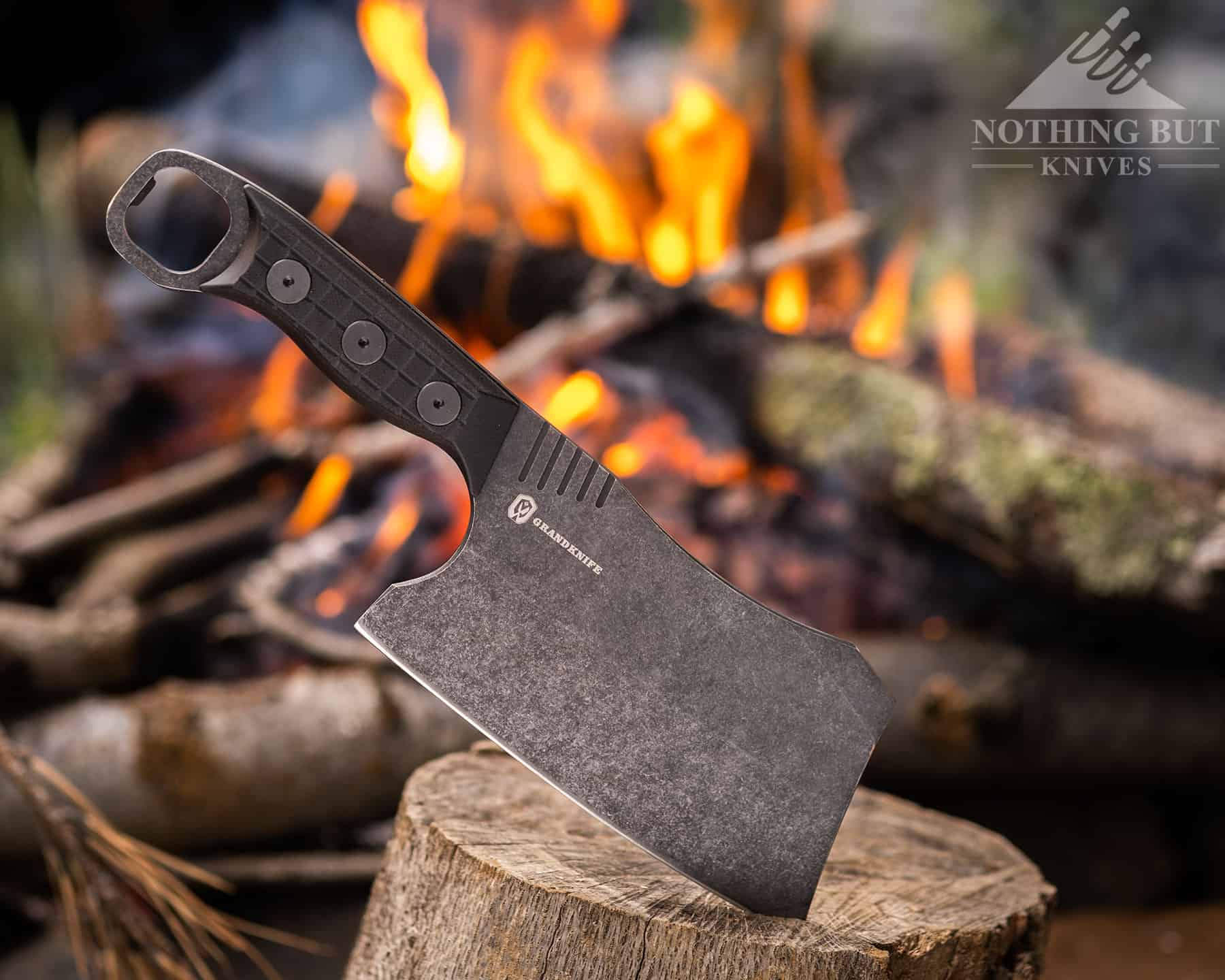
Back in early 2023, Vosteed launched a Kickstarter for the Minibarbar, pushing it as an outdoor food prep blade. The idea was to make it robust, versatile, and affordable. There were some other words attached, but those are the three this knife really hits hard
The Minibarbar isn’t Vosteed’s first food-centric knife by any stretch. Their Morgan line of kitchen knives showed they can make reliable, high-functioning blade for a tight budget. The Minibarbar is meant to be one of the early installments in their Grand Knife brand, though, which is meant to house future designs in the outdoor cooking category.
As of this writing, that’s a fresh ambition for the year, so we’ll see where it goes, but based on this cleaver, the Grand Knife name will be a mix of food-prep meets EDC that Vosteed seems well suited to thrive in.
Fit and Feel
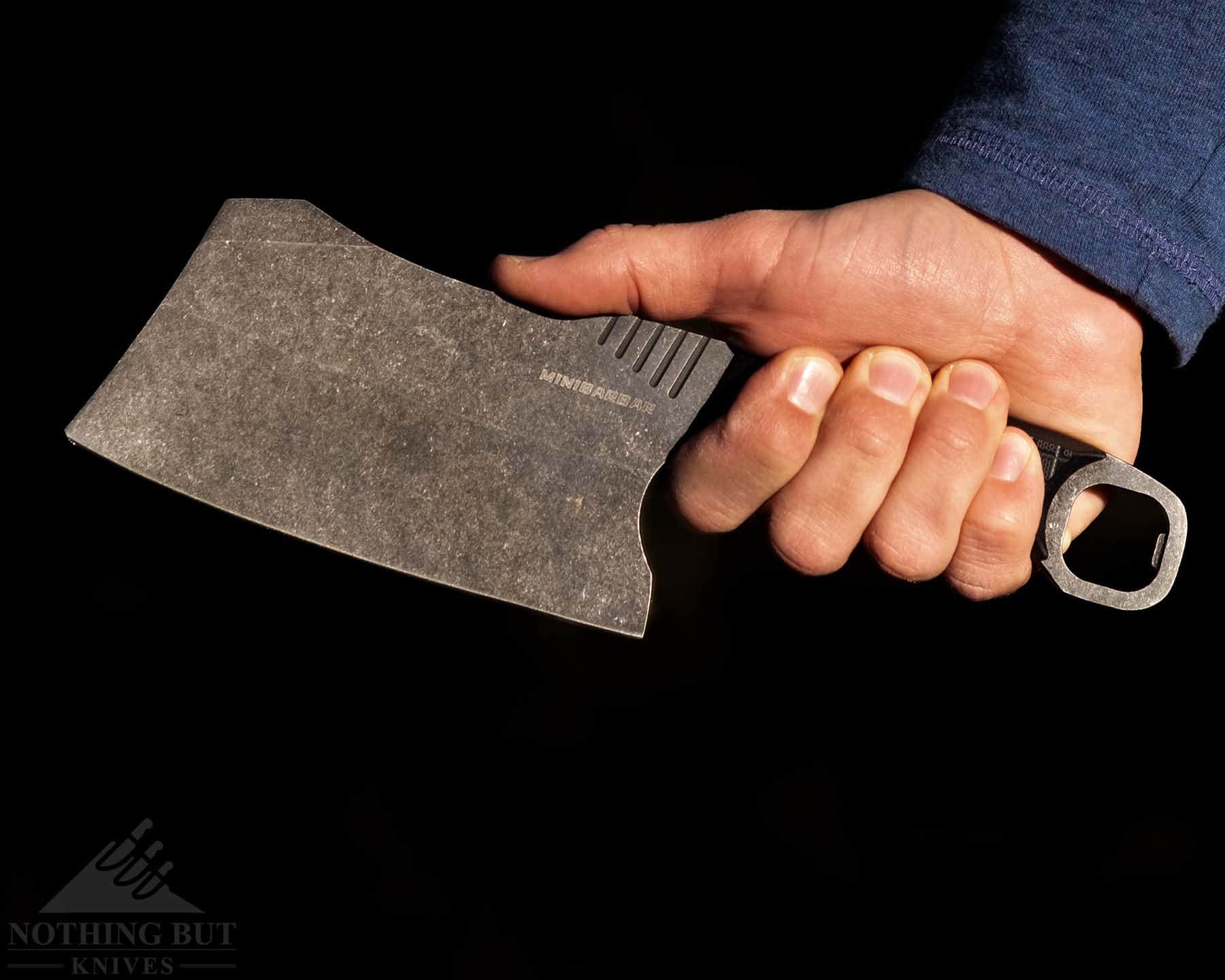
This has a great balance. It’s definitely blade-heavy the way a cleaver should be, but it’s closer to the handle than a lot of other cleavers thanks to the full tang that extends into a bottle opener at the pommel. That balance makes it feel nicer for cutting lighter foods like green onions, and for actually using the bottle opener because there’s more weight in the center of your grip, so there’s a stronger feeling of control.
There are also some nice details that help the grip. The scales are angled for a pinch grip, and there’s even texturing just above the scales to give the thumb and index finger a little more security. The curve of the spine also makes a Filipino grip feel pretty natural, although the lip of the scales do bite into the underside of my index finger when I hold it like that. I don’t generally use that grip for food prep, though, so no foul.
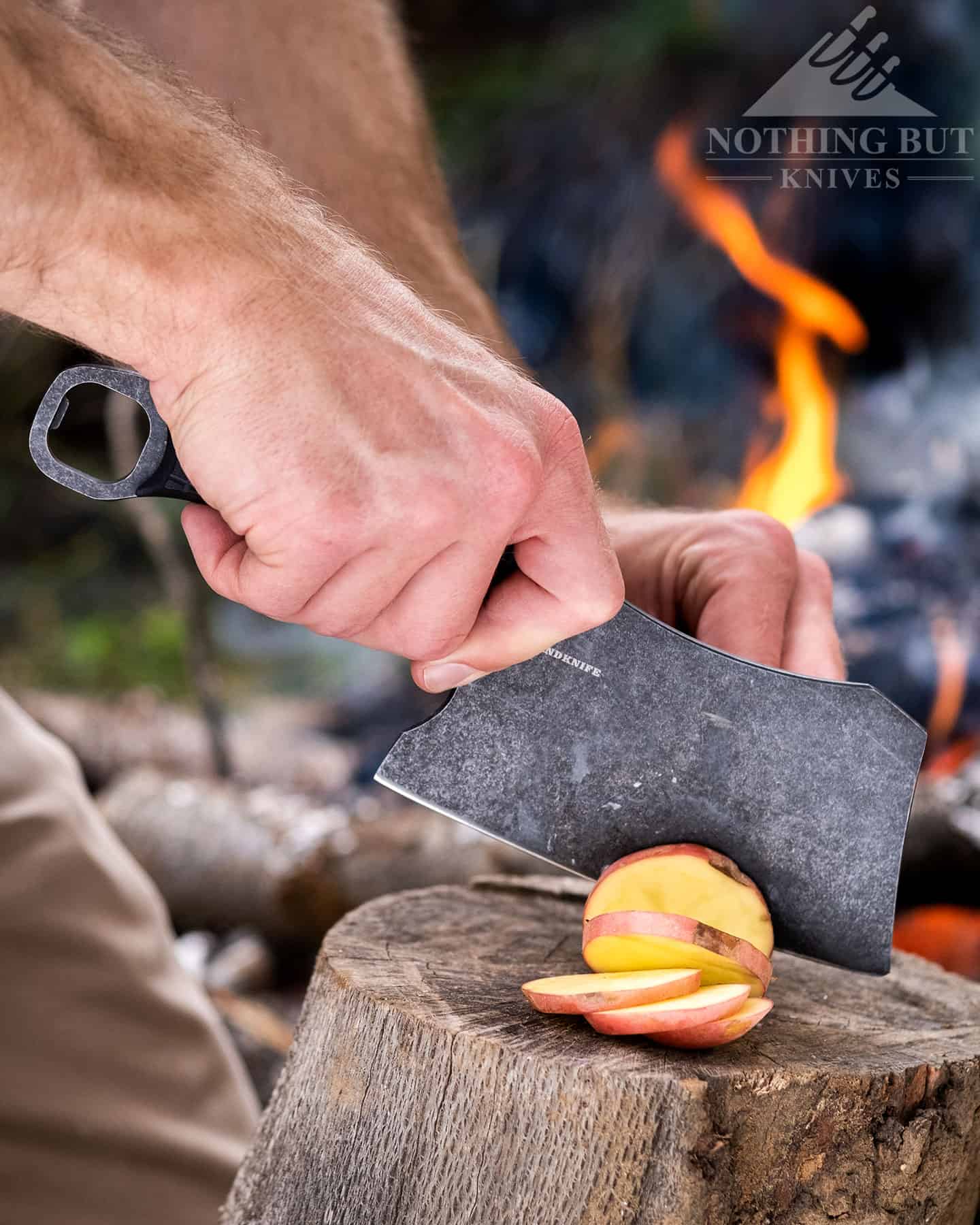
This is a big, heavy cleaver, though. The ergonomics are good for the most part, but they don’t stay that way for long. It bites hard in a pinch grip. There are a lot of hard angles on this thing, both on the spine, and around the top of the handle, so even though it can rough chop potatoes fairly well, I wouldn’t want to do a whole bag of them with the Minibarbar.
The bottle opener can be kind of tricky because the size of the ring forces the knife to go at a steep angle to get the tab under the cap that makes the leverage feel weaker. It gets the job done.
What about this Sheath
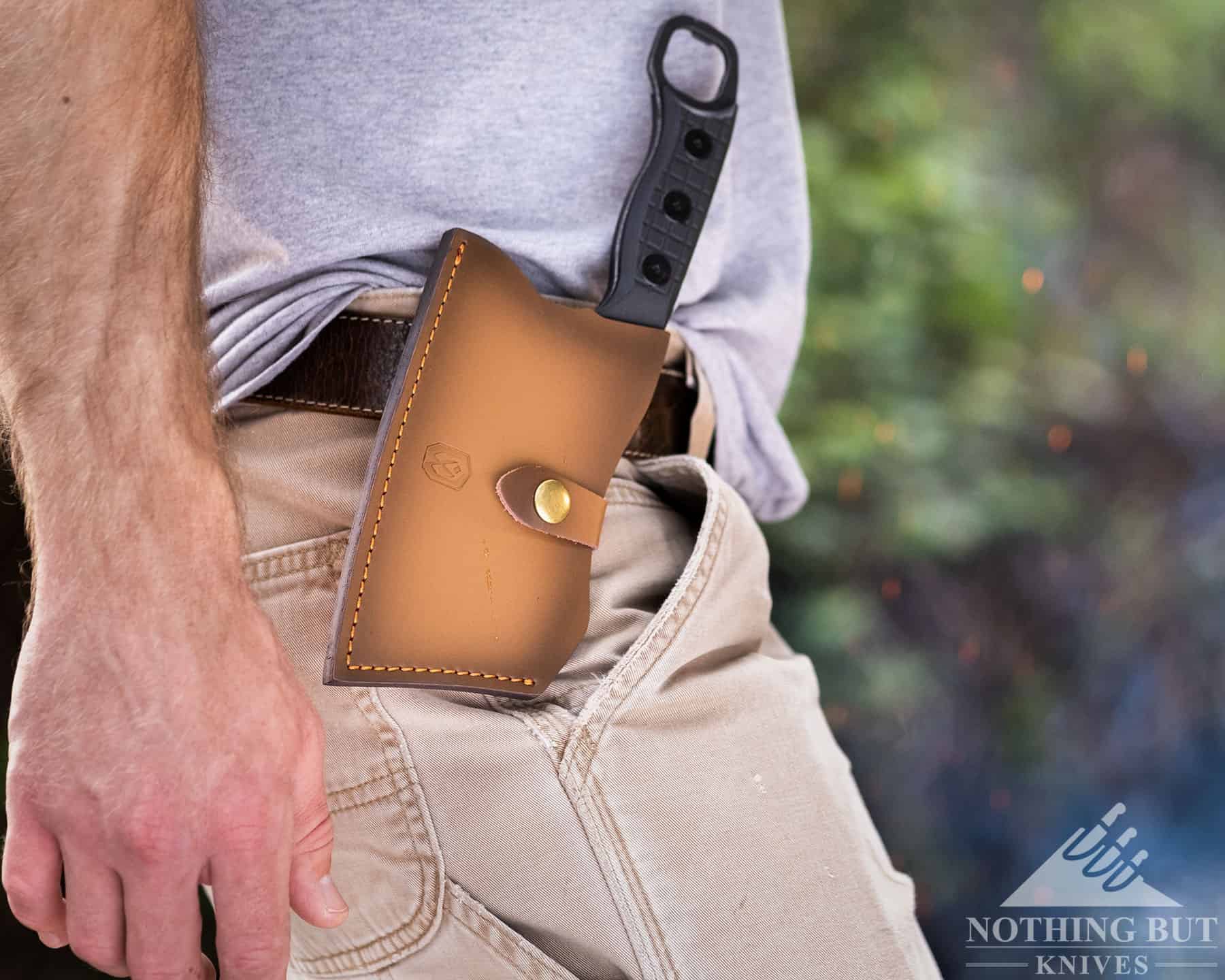
The Minibarbar sits a little awkwardly on the belt. The belt loop is pretty long and placed more toward the blade side of the sheath while all the weight of the knife is on the spine side so the handle leans heavy and moves around a lot.
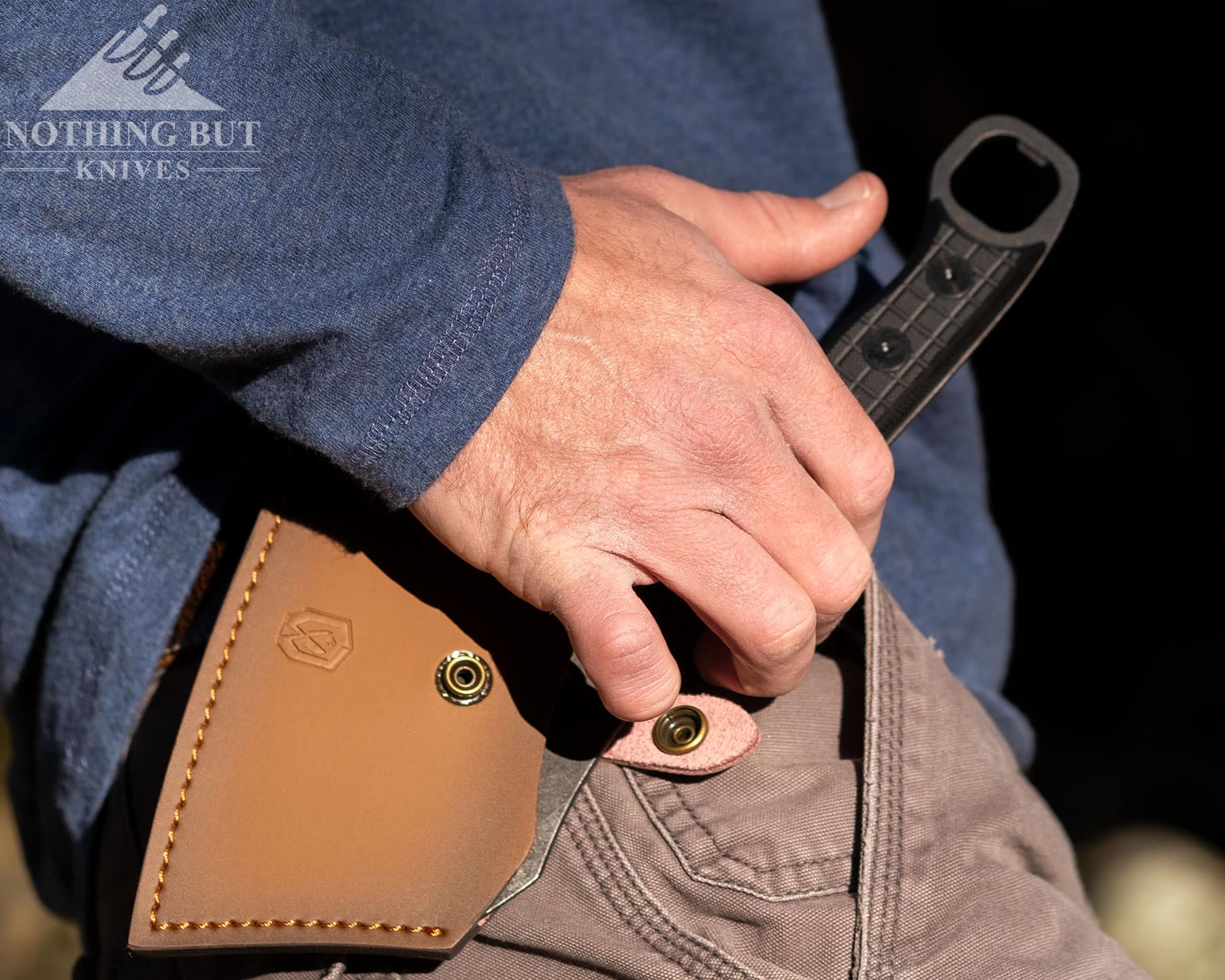
But the clasp is pretty strong, and the exposed back makes it easy to draw the knife out. I wouldn’t want to hike around with it, but if I’m sitting around a fire and standing at a grill, this works well enough.
The Blade
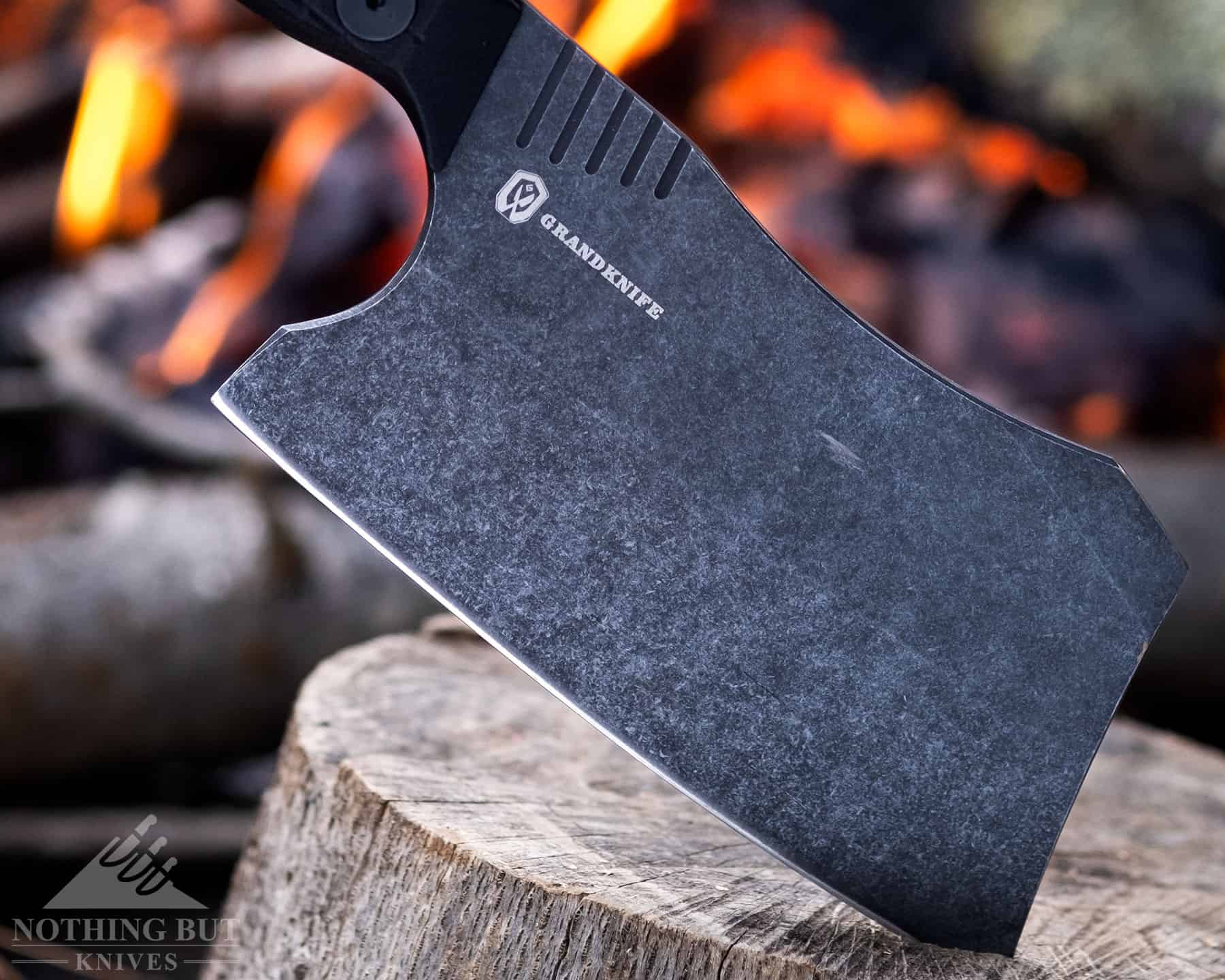
Yep. That’s a cleaver blade alright. It averages about three inches tall (from edge to spine), but the height that matters is the primary bevel, which goes about an inch and a half up the blade.
In practice, that turned out to mean a couple different things, both good and bad:
- It’s tough, with ax-like geometry,
- It has a feeling of gentle separation with meat,
- It has bad wedging problems with foods that are large, tough, and starchy (apples, potatoes, etc.)
- But don’t worry, the edge is still plenty sharp enough to work with thinner food.
This will all come up again in the food testing section, but I wanted to make sure to highlight the geometry here, partly because the grind doesn’t always show up in product pictures, and partly because I want to make sure you understand what this was made for and why it feels the way it does.
The Steel Works
I’ve seen a few people grumble at the steel on this, and I get that 7Cr17MoV steel is the equivalent of wet paper to enthusiasts, but a cleaver is actually one of the few kinds of knives I don’t particularly want super steel on. I take the Minibarbar out to abuse it. I like that it’s cheap and soft. That gives me an enormous amount of freedom to cut anywhere and anything. I don’t care if a rock chips the edge. There’s plenty of blade to grind it back to a decent edge.
In this case, the steel is a boon; not a burden. And if you really want an upgrade, they make this in a Damascus steel with 10Cr15CoMoV steel in the core, which is a VG10 equivalent. You’ll get plenty of edge retention with that.
Food Test
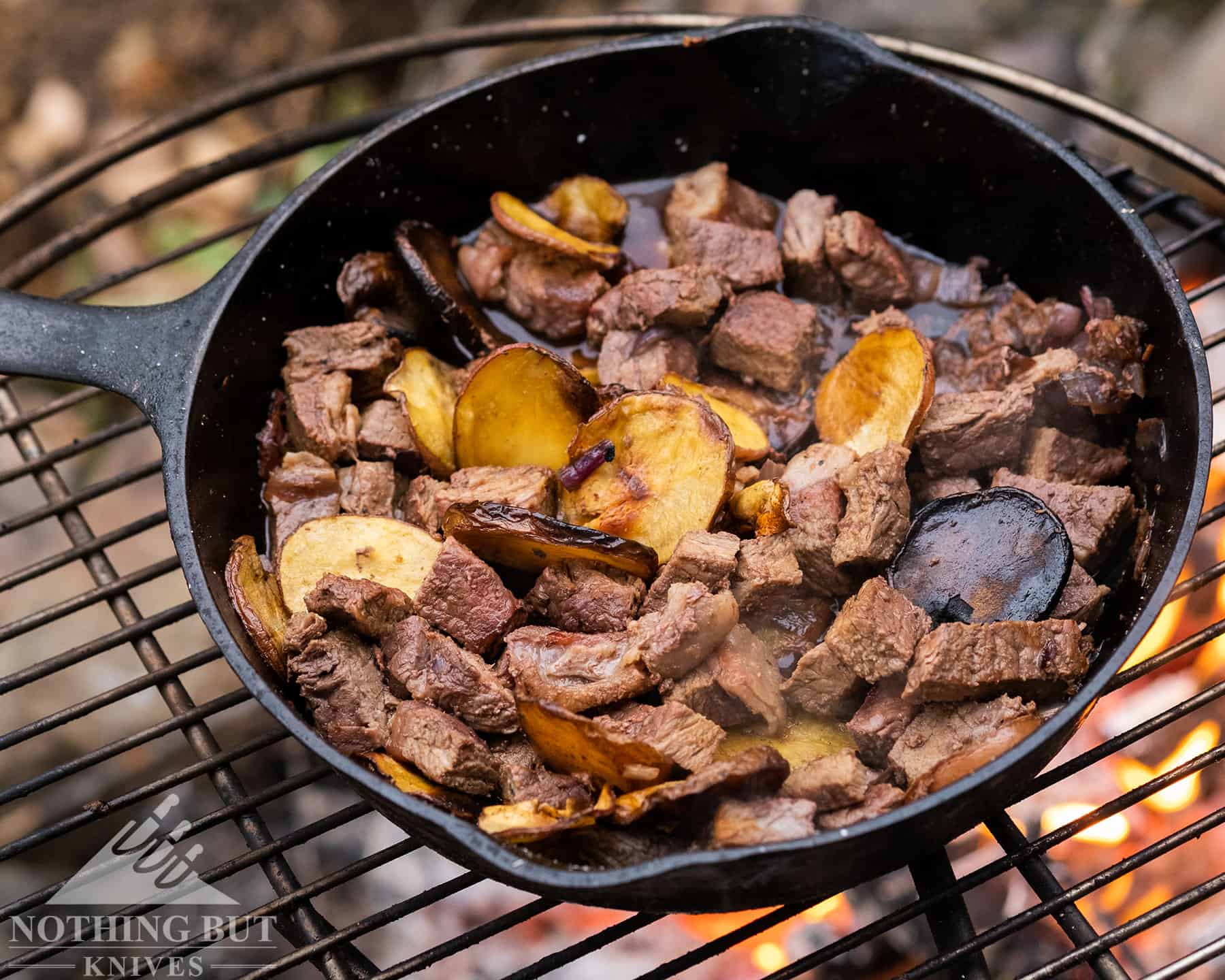
I was expecting the Minibarabar to handle proteins well, and I was right. I was surprised at how it performed with a few vegetables, though. It handles meat (raw and cooked) and greens really well, but I struggled a little with root vegetables and thicker, starchy foods.
Mushrooms
Makes nice clean cuts on mushrooms. I thought for sure it would tear most of the pieces up, but the edge is sharp enough to cut clean, and the behind-the-edge geometry has a surprisingly gentle touch on softer, spongy foods like this.
Meat (chicken and beef)
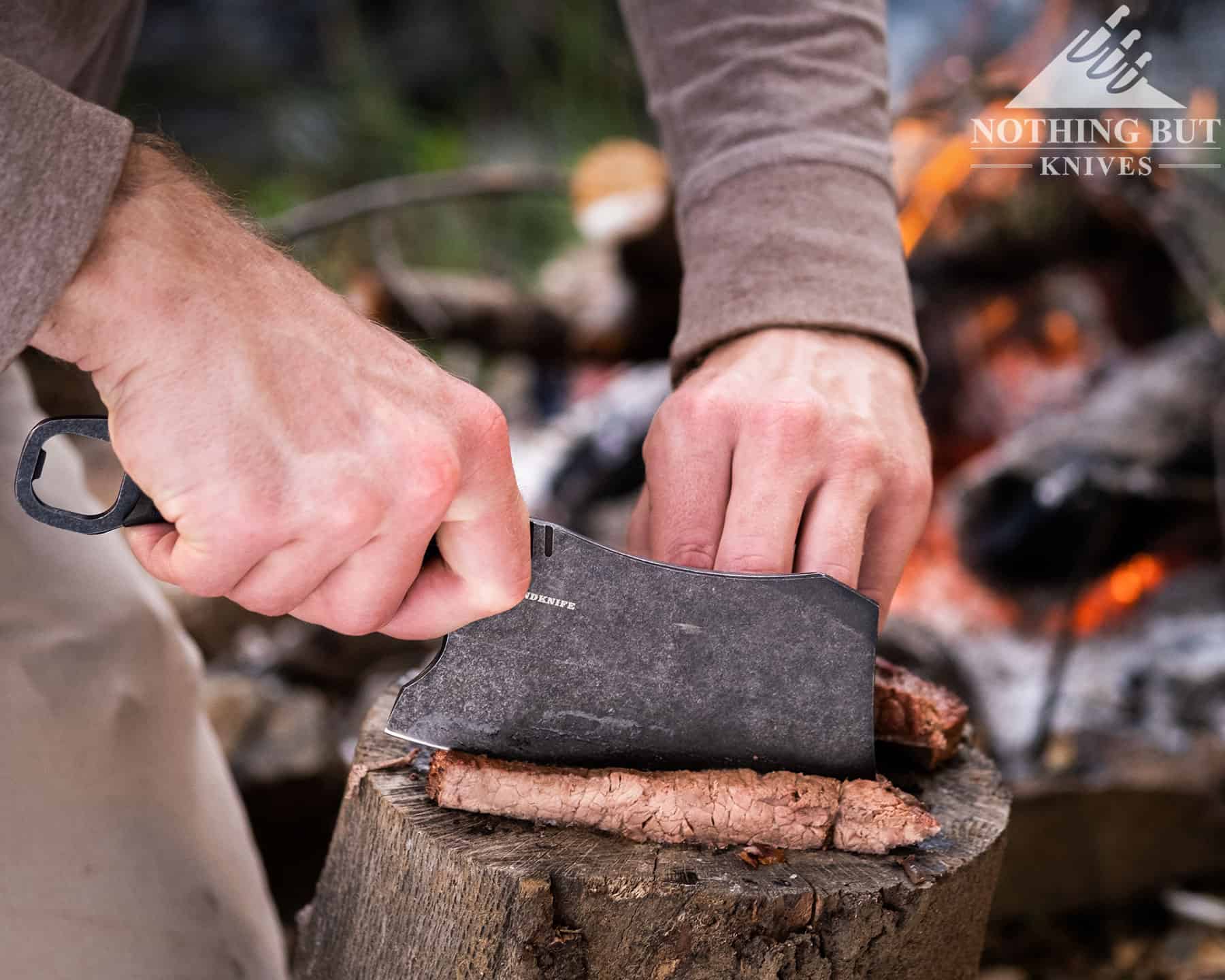
Sort of in the vein of spongy foods, this cleaver feels great for cutting large cuts of meat. When I had a big slab of steak, especially if it had bone in it, the Minibarbar became the thing I loved to reach for.The edge started cuts without an effort, and the wide blade pushed most slices away from the blade so I got nice separation on my cuts.
I also used this to parcel out pieces of cooked chicken for things like sandwiches and salads and had a similar experience. Meat is really this thing’s specialty.
Apples
Normally I don’t talk about this test (even though I test every knife on an apple first), but in this case I actually felt some pretty bad resistance.
Potatoes
Oddly, it felt better with potatoes. Maybe because I was cutting smaller red potatoes that might not have been as dense as the fuji apples I’d been snacking on. Doing a rough chop on potatoes for a stir fry or a chili wasn’t too bad, but I wouldn’t want to use this for hosting Thanksgiving.
Greens
It had a very crisp cut on leafy greens like spinach and kale. The only detracting factor to speed and precision was the weight of the blade.
Peppers
It might be more the weight than the edge, but this has no problem biting into a big smooth bell pepper.
It was a little awkward to open peppers up, roll them out, and cut from the inside, but the end result still looked pretty good.
Comparison and Alternatives
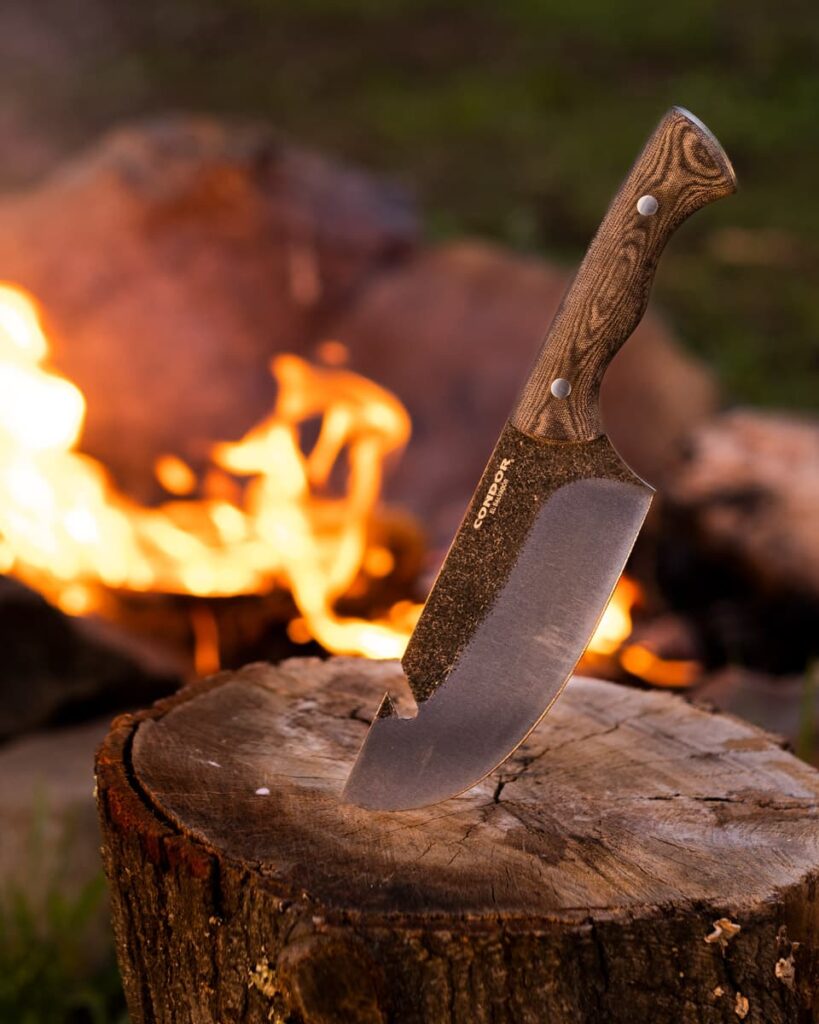
As a cleaver the Minibarbar is somewhat unique thanks to its size and styling, so my thoughts on recommendations went a couple different directions.
The Condor Bush Slicer isn’t really a cleaver, but it definitely feels like one in hand. The convex grind is nice for cutting meat, but not so much for thinner and lighter foods. On the whole it’s more of a camping knife than a kitchen knife.
The Bavarian Knife Works Asian cleaver from their Dreamcut series is an excellent performer in the kitchen. I’ve used it regularly for just about everything, but it doesn’t have the Minibarbar’s outdoor bbqing specialization.
My Final Thoughts, Opinions and Musings.

This is an excellent barbecue blade. The edge handles most meats without an issue, and the foods it does have an issue with you can still cut reasonably well with some practice and elbow grease. The main thing holding it back is the weight. If it were lighter, I’d be happy to use it to make a meal for ten people (at least, as happy as I’m capable of being in that scenario).
But as it is, the Minibarbar is the tool to hang beside your grill, right next to the beer cooler.
